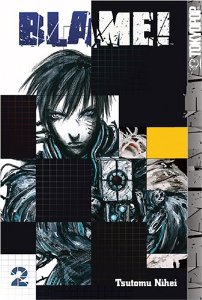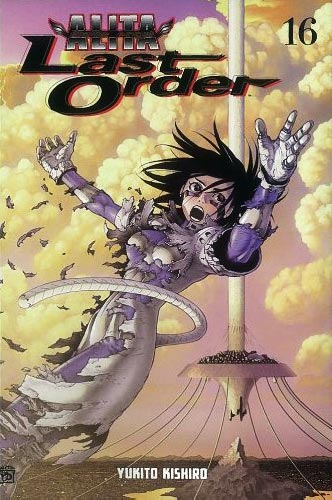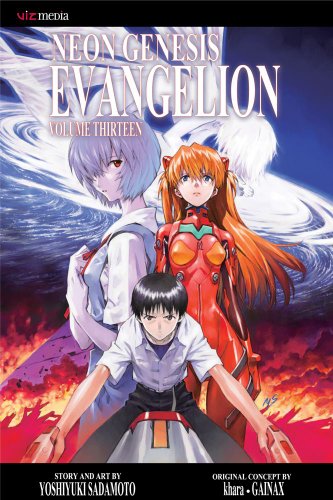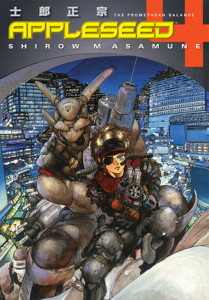SF Manga 101: Mobile Suit Gundam
Glenn Hough (gallyangel) is a nonpracticing futurist, an anime and manga otaku, and is almost obsessive about finishing several of the lists tracked on WWEnd. In this series on SF Manga Glenn will provide an overview of the medium and the place of science fiction within it.
 Do you know anyone who couldn’t give you a basic outline of either Star Trek or Star Wars? And I mean just a basic sentence. Star Trek: The crew of a starship out having adventures as they explore space. Star Wars: Good and Evil in a galaxy spanning milieu. Who, I wonder, can not do that in the U.S., if not most of the world where U.S. culture has touched?
Do you know anyone who couldn’t give you a basic outline of either Star Trek or Star Wars? And I mean just a basic sentence. Star Trek: The crew of a starship out having adventures as they explore space. Star Wars: Good and Evil in a galaxy spanning milieu. Who, I wonder, can not do that in the U.S., if not most of the world where U.S. culture has touched?
Let’s take it a step further and ask if there are any Brits who can’t do the same thing for Doctor Who? The tagline: An immortal time traveler out having adventures as he explores the universe. There’s the high probability that something resembling a 60ies era British phone booth is involved.
What I’m getting at here are franchise works, cross media, which have embedded themselves into the bedrock strata of a national culture. Just like a particular food or cooking methodology is embedded in a country and culture, these SF franchises are just part of what that country is all about. When one talks about SF manga or anime, Mobile Suit Gundam, or just Gundam, is that type of work. It’s part of the bedrock cultural attributes of Japan.
SF Manga 101: Ghost in the Shell – Stand Alone Complex
Glenn Hough (gallyangel) is a nonpracticing futurist, an anime and manga otaku, and is almost obsessive about finishing several of the lists tracked on WWEnd. In this series on SF Manga Glenn will provide an overview of the medium and the place of science fiction within it.
 And in the Beginning there was the Major…
And in the Beginning there was the Major…
What Shirow started over two decades ago is still rolling along. The Ghost in the Shell manga I talked about way back at the start of this little series, is now informally known as GITS 1.0, which is followed by GITS 1.5 and GITS 2.0. Next come the Stand Alone Complex series of takubons and three original novels. There have also been three movies, two seasons of the Stand Alone Complex TV series, and numerous specials. As of this writing, the newest installment OAV, Ghost in the Shell: Arise (which concerns how the Major was recruited and Section 9 was created) is just out. The accompanying manga is also just out in the monthly anthologies and has not even been collected into a takubon yet. This just about sums up the official GITS franchise. Oh, did I mention games. Can’t forget about those and all of their accompanying books. (Imagine the shelf space it all takes up!)
This is what Kodansha says about the first manga Takubon of GITS:SAC.
Stand Alone Complex takes place in the year 2030, in the fictional Japanese city of New Port. The story follows the members of Public Security Section 9, a special-operations task-force made up of former military officers and police detectives. The manga presents individual cases that Section 9 investigates, along with an ongoing, more serious investigation into the serial killer and hacker known only as “The Laughing Man.”
SF Manga 101: Blame! and it’s prequel Noise
Glenn Hough (gallyangel) is a nonpracticing futurist, an anime and manga otaku, and is almost obsessive about finishing several of the lists tracked on WWEnd. In this series on SF Manga Glenn will provide an overview of the medium and the place of science fiction within it.
 And now for something completely utterly different.
And now for something completely utterly different.
The last four mangas I’ve blogged about, Twin Spica, Planetes, 7 Billion Needles and Chobits, all have a core slice-of-life normalcy to them that the SF elements wrap or entwine themselves around. It’s time to leave anything and everything of the mundane world totally behind and enter Killy’s world.
Tokyopop says this about Tsutomu Nihei’s Blame!:
In a future world rife with decay and destruction, Killy is a man of few words who packs one very powerful gun. He wanders an endless labyrinth of cyberdungeons filled with concrete and steel, fighting off cyborgs and other bizarre silicate creatures. Everyone is searching for the fabled Net Terminal Genes, but no one is quite certain what kind of power they contain. The answer may lie hidden among the scattered human settlements of this vast and desolate future world.
SF Manga 101: Chobits
Glenn Hough (gallyangel) is a nonpracticing futurist, an anime and manga otaku, and is almost obsessive about finishing several of the lists tracked on WWEnd. In this series on SF Manga Glenn will provide an overview of the medium and the place of science fiction within it.
 Imagine, for a moment, a group of lady doujinshi artists. Imagine them hurrying from their train to the comicfest doujinshi sales halls, in the very early morning, the summer heat already starting to rise. It is the mid 80ies and there are eleven or twelve of them in their circle. Imagine them having the fun of shopping through the packed doujinshi isles, stopping to chat and exclaim over the precious fan work they find. They do this in shifts so they can sell their own work as well. Imagine their doujinshi getting into the hands of the right person. Imagine the right conversation with the right person in the manga industry. Imagine rejection before a second chance with a different work.
Imagine, for a moment, a group of lady doujinshi artists. Imagine them hurrying from their train to the comicfest doujinshi sales halls, in the very early morning, the summer heat already starting to rise. It is the mid 80ies and there are eleven or twelve of them in their circle. Imagine them having the fun of shopping through the packed doujinshi isles, stopping to chat and exclaim over the precious fan work they find. They do this in shifts so they can sell their own work as well. Imagine their doujinshi getting into the hands of the right person. Imagine the right conversation with the right person in the manga industry. Imagine rejection before a second chance with a different work.
By the time we get to their first published professional work in 1989, the group is now seven. By 1993 that amateur doujinshi group of a dozen or so has shrunk to four. Those four are collectively known as Clamp, who have secured for themselves the reputation of being one of the current Manga Gods of Japan.
SF Manga 101: Planetes and 7 Billion Needles
Glenn Hough (gallyangel) is a nonpracticing futurist, an anime and manga otaku, and is almost obsessive about finishing several of the lists tracked on WWEnd. In this series on SF Manga Glenn will provide an overview of the medium and the place of science fiction within it.
 Over the last several years, there have been a few articles published on space junk. This is an issue which generally simmers in the background of space travel, with the occasional additional emphasis period. Some of those articles focus on the need for treaty work to help limit the amounts of new junk added to the ever expanding cloud, while others talk about ways in which junk could be cleaned up with robot satellites specifically designed for that purpose. There are approximately 22,000 pieces of space trash being actively tracked. The experts think that there are in the neighborhood of 500,000 objects in the 1 to 10 cm size range which aren’t being tracked. A 1 cm size object, like a hexagon nut for instance, doesn’t sound very dangerous, but this nut is traveling at orbital speed. Do the words “Explosive Decompression” mean anything to you?
Over the last several years, there have been a few articles published on space junk. This is an issue which generally simmers in the background of space travel, with the occasional additional emphasis period. Some of those articles focus on the need for treaty work to help limit the amounts of new junk added to the ever expanding cloud, while others talk about ways in which junk could be cleaned up with robot satellites specifically designed for that purpose. There are approximately 22,000 pieces of space trash being actively tracked. The experts think that there are in the neighborhood of 500,000 objects in the 1 to 10 cm size range which aren’t being tracked. A 1 cm size object, like a hexagon nut for instance, doesn’t sound very dangerous, but this nut is traveling at orbital speed. Do the words “Explosive Decompression” mean anything to you?
SF Manga 101: Twin Spica
Glenn Hough (gallyangel) is a nonpracticing futurist, an anime and manga otaku, and is almost obsessive about finishing several of the lists tracked on WWEnd. In this series on SF Manga Glenn will provide an overview of the medium and the place of science fiction within it.
 From the Big Dipper, take the arc to Arcturus. Drive a spike to Spica.
From the Big Dipper, take the arc to Arcturus. Drive a spike to Spica.
The star Spica in the constellation of Virgo is actually thought to be a binary star system about 262 light years away from Earth. Twin Spica. But even this is in doubt. There may be more stars in that system; it might be up to a quintuple system.
And no, the lead character of Twin Spica is not from this system. It’s where thirteen year old Asumi Kamogawa is looking to go. To the stars.
The publisher says this about Twin Spica:
In a Tokyo of the not-too-distant future a young girl looks up to the stars with melancholy in her heart and hope in her eyes. Thirteen-year-old Asumi Kamogawa’s life has been tied to those stars; her future may very well be among them. And she is not alone… Asumi is one of many young people with ambitions to some day head off to space for Japan’s first manned mission.
 Before liftoff, like any true astronaut she must show the right stuff and overcome odds to pass numerous physical and mental trials if she even wants to be considered in the running for a rare spot in the elite Tokyo Space School.
Before liftoff, like any true astronaut she must show the right stuff and overcome odds to pass numerous physical and mental trials if she even wants to be considered in the running for a rare spot in the elite Tokyo Space School.
Have you ever sat and talked to or listened to someone on TV who was in their early 20ies or teens during the height of the Apollo era? Do you hear the passion in their voice, still, after all this time? Do you understand that for them, space was not a trivial thing? It meant something. It was a striving, a growing, a throwing off the shackles of the past for something nobody had tried to do before. We’d dreamed of it certainly, but never before had the physics or technical knowledge been ours so that we could try. Space was our future and we were going for it. Space mattered then, in a way it does not matter now. And the spirit we had then, is what moves Twin Spica.
SF Manga 101: The Voices of a Distant Star & A, A’ (A, A Prime)
Glenn Hough (gallyangel) is a nonpracticing futurist, an anime and manga otaku, and is almost obsessive about finishing several of the lists tracked on WWEnd. In this series on SF Manga Glenn will provide an overview of the medium and the place of science fiction within it.
As the lights dim and the previews end, it’s time to settle back with a favorite snack for a double feature. Since these two mangas are far shorter than normal, we won’t be here as long.
The Voices of a Distant Star was initially created by Makoto Shinkai who is one of those people anime otaku pay attention to. He’s not a newcomer anymore. Voices, as an anime, was one of the works which cemented his status in Japan and around the world as someone to watch. Mizu Sahara, which is just one of several pen names that Sumomo Yumeka uses, adapted the anime to manga. And finally, on my ninth blog, the gender bias in SF manga cracks. Yumeka is our first women.
I’m afraid we must acknowledge a gender bias here. Lady mangaka seem to write infrequently in the pure SF manga genre. If I was writing about magical realism, fantasy or high fantasy, I already would’ve talked about several efforts by both manga gods Rumiko Takahashi and the CLAMP quartet. But I’m doing SF. The ladies own other genres in Japan and seem to make infrequent forays into SF. And then, of course, the publishing houses here only want the best, or what will sell the best (that’s really the key) so this shrinks the available pool of possible SF by women even more. Add my own biases and lack of funds, and that shrinks the pool further. So, I’m neither dismayed nor surprised that it’s taken until the 9th blog to get to two female voices in SF manga. It’s really a matter of knowing that the bias is there, so specifically seeking out the exceptions, is the only real way to counter it.
SF Manga 101: Battle Angel Alita & Battle Angel Alita: Last Order
Glenn Hough (gallyangel) is a nonpracticing futurist, an anime and manga otaku, and is almost obsessive about finishing several of the lists tracked on WWEnd. In this series on SF Manga Glenn will provide an overview of the medium and the place of science fiction within it.
 Two very strange things happened with Battle Angel during it’s production, which, good god!, started in 1991 and is still going on. When it came to the states, VIZ, for reasons I’ve never been able to find out or figure out, changed the name of the title character to Alita. Her name is Gally in the original. Obviously, no one at Viz looked up the word Gally in the OED. Why would they? Gally, in colloquial english, just means to inspire the fear of death. Root word is probably gallows. As the manga unfolds, we see that Gally certainly is someone who inspires the fear of death.
Two very strange things happened with Battle Angel during it’s production, which, good god!, started in 1991 and is still going on. When it came to the states, VIZ, for reasons I’ve never been able to find out or figure out, changed the name of the title character to Alita. Her name is Gally in the original. Obviously, no one at Viz looked up the word Gally in the OED. Why would they? Gally, in colloquial english, just means to inspire the fear of death. Root word is probably gallows. As the manga unfolds, we see that Gally certainly is someone who inspires the fear of death.
The second strange thing is Kishiro ended Battle Angel with volume 9. This is only strange since volume 17 of the Last Order arc is due out this month. I’ve heard he was pressured to end it; he was canceled. I’ve heard he rushed the ending due to illness and then couldn’t stand that ending. I’ve heard a lot of things so I don’t know what’s true. What I do know is that Kishiro goes on to another project but returns to Battle Angel a few years later. An omnibus version of Battle Angel appeared in Japan and the last few chapters of volume 9 were lopped off from that edition. The chapters which wraps things up are gone and Kishiro proceeds into the Last Order arc as if he’s just taken time off from the series. It’s as if that ending never happened. Now that I’m more familiar with how the manga system works in Japan, I certainly respect this author for asserting control over his work, which is not always the case over there.
SF Manga 101: Neon Genesis Evangelion
Glenn Hough (gallyangel) is a nonpracticing futurist, an anime and manga otaku, and is almost obsessive about finishing several of the lists tracked on WWEnd. In this series on SF Manga Glenn will provide an overview of the medium and the place of science fiction within it.
 Abandon all hope, all ye who enter here!
Abandon all hope, all ye who enter here!
Neon Genesis Evangelion, or NGE, has been known to do things to people; it changes them. You have been warned.
When otaku start talking about the NGE anime, it’s normal to talk in clichés and you start to use words or phrases like ground breaking, shattering, stunning, mind-numbing complexity, totally awesome, Rei is so Moe, Or Baka! Shinji (You fool, Shinji!).
When the anime hit in 95 and 96 to say that it changed the face of anime and that it reforged the big giant mecha genre, is not an understatement or hyperbole. That’s what happened. But NGE didn’t just stop. The anime had several movies, which tied up the ending of the series, before moving on to a rebuild series of movies that clarified and distilled the major themes, concentrating and enhancing what was already there.
Now the manga is what we would call a novelization. And they’re still being produced, even after almost a lapse of 20 years. One of the leads from the anime is doing this. Yoshiyuki Sadamoto is sort of slow and there have been pauses in the production. That’s just the way it worked out. But this slowness has allowed the manga to follow it’s own process of distillation and clarification, making for a more concise rendering of the basic story line. I feel the manga stands by itself and is good enough for a top five placement in the SF manga pantheon.
SF Manga 101: Appleseed
Glenn Hough (gallyangel) is a nonpracticing futurist, an anime and manga otaku, and is almost obsessive about finishing several of the lists tracked on WWEnd. In this series on SF Manga Glenn will provide an overview of the medium and the place of science fiction within it.
 When I was charting out the mangas I’d be blogging about, my best of the best list, and why those mangas should matter to us, the SF reading public, Masumune Shirow found his way onto the list three times. Conversely, nobody else even got a second series. That’s the level of difference we’re talking about with Shirow.
When I was charting out the mangas I’d be blogging about, my best of the best list, and why those mangas should matter to us, the SF reading public, Masumune Shirow found his way onto the list three times. Conversely, nobody else even got a second series. That’s the level of difference we’re talking about with Shirow.
I find it highly ironic that the ideas for Ghost in the Shell (GITS) came out of Appleseed. And in my opinion, knocked Appleseed out of a top three slot for SF Manga. Not out of the top five, but out of the top three.
This is what the publisher says about the first volume of Appleseed.
World War III is over, and nomad soldier Duenan Knute and her cyborg partner Briareos struggle to survive in the abandoned cities and demilitarized zones of the post-war wasteland, the “Badside.” Matters appear on the upswing, however, when they are found and brought to Olympus, an urban utopia and centerpiece for the reconstruction of civilization. Duenan and Bri join the Olympus police, a force that seems hardly necessary in such a paradise. But, like in most pretty pictures, perfection is an illusion, and Olympus’s peaceful facade hides a dark secret, a violent struggle between human and cyborg that could once again plunge the world into war… and genocide.



















 Full Details
Full Details


